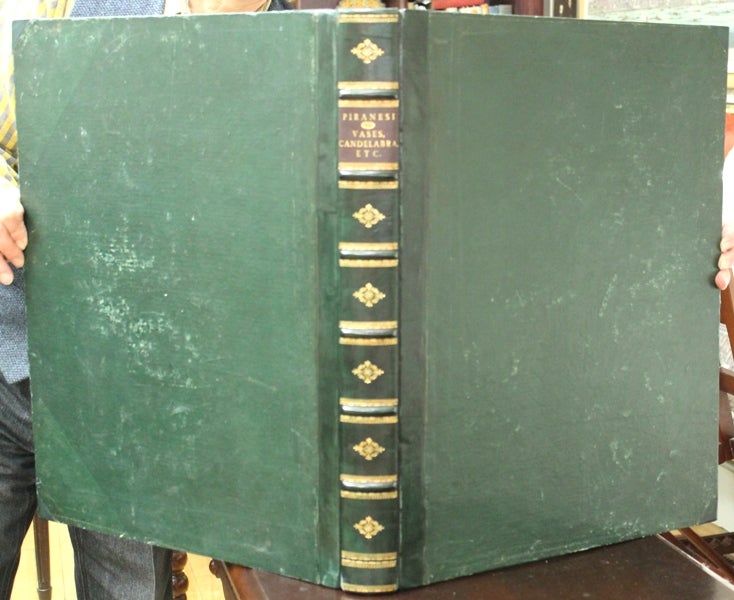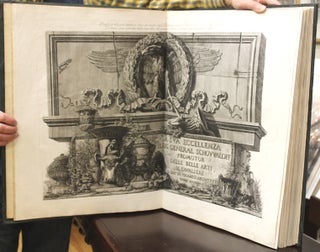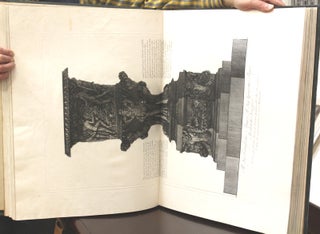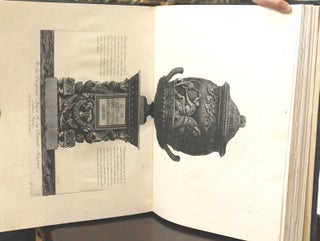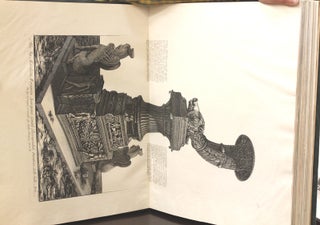Vasi, Candelabri, Cippi, Sarcofagi, Tripodi, Lucerne, Ed Ornamenti ...
Paris. c.1800-1830. Binding: Contemporary half paper boards, rebacked expertly, spine with 6 raised bands, title in gilt on two, compartments with decorative gilt devices and ruling., Notes: Piranesi began from 1768 to issue individual plates from this series. Most of these etching, which were later collected together for this two-volume series, of 112 plates. Piranesi provided detailed inscriptions on many of the plates and these give much useful information about the original discovery and contemporary location of the objects concerned.
Giovanni Battista Piranesi (1720 – 1778) was an Italian artist famous for his etchings of Rome and of fictitious and atmospheric "prisons" (Le Carceri d'Invenzione). He was the father of Francesco Piranesi and Laura Piranesi. It is important to look at his contribution as an archaeologist, which was acknowledged at the time as he had been elected to the Society of Antiquaries of London. His influence of technical drawings in antiquarian publications is often overshadowed. He left explanatory notes in the lower margin about the structure and ornament. Most ancient monuments in Rome were abandoned in fields and gardens. Piranesi tried to preserve them with his engravings. To do this, Piranesi pushed himself to achieve realism in his work. A third of the monuments in Piranesi's engravings have disappeared, and the stucco and surfacing were often stolen, restored and modified clumsily. Piranesi's precise observational skills allow people to experience the atmosphere in Rome in the eighteenth century. Piranesi may have recognised his role to disseminate remarkable information through meaningful images. He became the Director of the Portici Museum in 1751.
This album consists of the most decorative plates from the series of Vasi, Candelabri, etc.
, Size: Folio (560 x 430 mm). , Illustration: Illustrated with the title page of the second volume of the work and a selection of 65 best plates (of 112) of vases ..., designed and etched by Cavalieri Giovanni Battista Piranesi published in Paris after Rome, with margins and the usual central vertical fold., Volume: Two volumes in one., Provenance: Ex-Libris of Edward Francis Searles on the upper verso., References: John Wilton Ely (F. II); Millard 101, Category: Book Europe Italy; Book Art, Architecture & Design; Book Antiquities; Book Plate Books General;. A superb album of the Paris edition of this important work on laid & wove paper. A fine example, plates are clean and crisp. Item #B6405
Binding: Contemporary half paper boards, rebacked expertly, spine with 6 raised bands, title in gilt on two, compartments with decorative gilt devices and ruling., Notes: Piranesi began from 1768 to issue individual plates from this series. Most of these etching, which were later collected together for this two-volume series, of 112 plates. Piranesi provided detailed inscriptions on many of the plates and these give much useful information about the original discovery and contemporary location of the objects concerned.
Giovanni Battista Piranesi (1720 – 1778) was an Italian artist famous for his etchings of Rome and of fictitious and atmospheric "prisons" (Le Carceri d'Invenzione). He was the father of Francesco Piranesi and Laura Piranesi. It is important to look at his contribution as an archaeologist, which was acknowledged at the time as he had been elected to the Society of Antiquaries of London. His influence of technical drawings in antiquarian publications is often overshadowed. He left explanatory notes in the lower margin about the structure and ornament. Most ancient monuments in Rome were abandoned in fields and gardens. Piranesi tried to preserve them with his engravings. To do this, Piranesi pushed himself to achieve realism in his work. A third of the monuments in Piranesi's engravings have disappeared, and the stucco and surfacing were often stolen, restored and modified clumsily. Piranesi's precise observational skills allow people to experience the atmosphere in Rome in the eighteenth century. Piranesi may have recognised his role to disseminate remarkable information through meaningful images. He became the Director of the Portici Museum in 1751.
This album consists of the most decorative plates from the series of Vasi, Candelabri, etc.
, Size: Folio (560 x 430 mm). , Illustration: Illustrated with the title page of the second volume of the work and a selection of 65 best plates (of 112) of vases ..., designed and etched by Cavalieri Giovanni Battista Piranesi published in Paris after Rome, with margins and the usual central vertical fold., Volume: Two volumes in one., Provenance: Ex-Libris of Edward Francis Searles on the upper verso., References: John Wilton Ely (F. II); Millard 101, Category: Book Europe Italy; Book Art, Architecture & Design; Book Antiquities; Book Plate Books General;.
Price: $25,000.00

